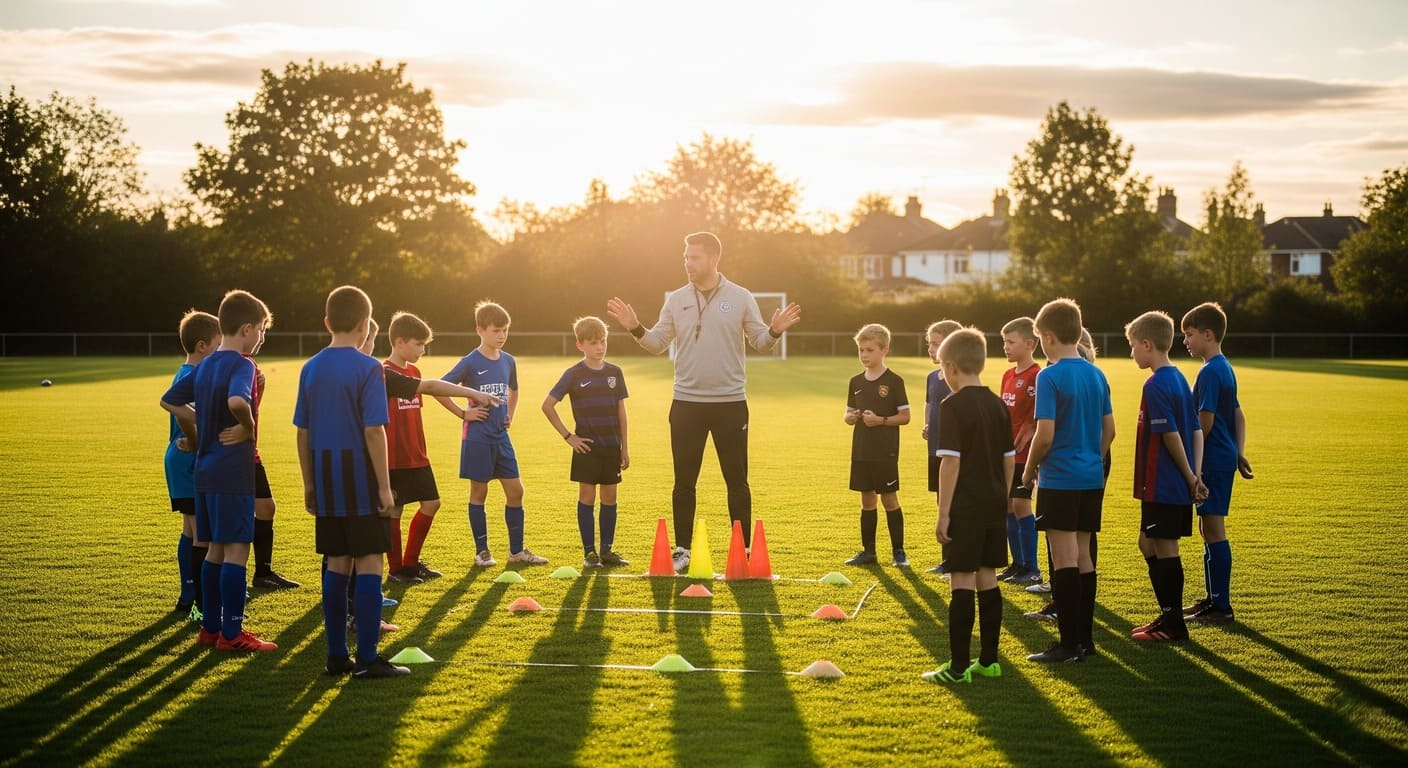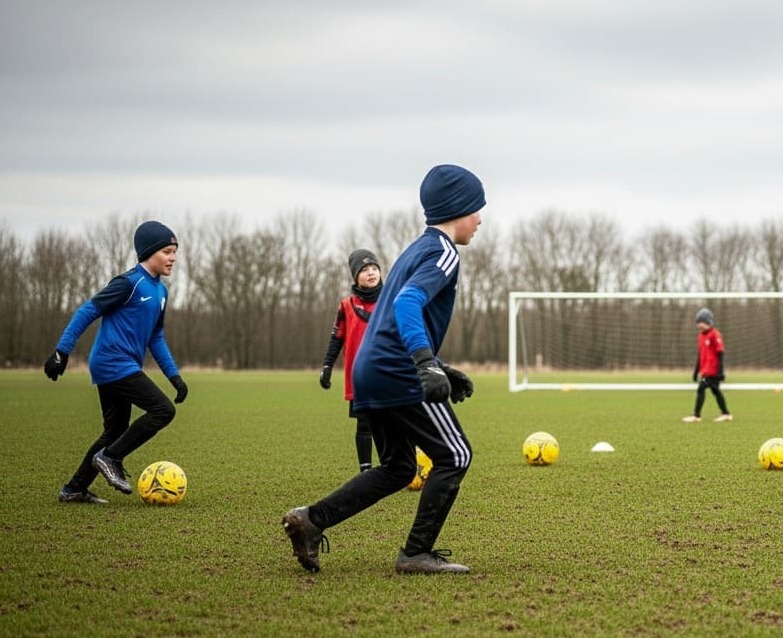Mastering 9v9 Football: The Ultimate Guide to Formations & Tactics
What Is 9v9 Football?
9v9 football is a critical transitional format used in youth development that lies between the smaller-sided structures of 5v5 and 7v7, and the full 11-a-side game. On the surface, 9 side football may look like a scaled-up playground game-but to an attentive coach, it unlocks structured learning full of space, tempo, and tactical decision making.
It challenges players to move beyond merely working with the ball by introducing them to team structure, spacing, and off-the-ball intelligence. Not only is this format essential for physical scaling-it’s the true beginning of football formations and positions that demand deeper recognition and execution.
Who Plays 9v9?
-
Ages: U11 to U13 (commonly between 9 and 12 years old)
-
Where: Grassroots leagues, development academies, elite pre-pro circuits
-
Pitch size: ~70x50 yards with intermediate-size goals
-
Ball size: Size 4 (standard across most federations)
-
Game length: Typically 2x25 or 2x30-minute halves
At this age and format, concepts like zoning, compactness, transition, and tactical identity can start to become internalised.
What Makes It Unique?
Unlike 7v7 or 5v5, 9 on 9 football introduces full-form spacing: a backline, a midfield layer, and a true attacking line. Mistakes are still recoverable, which makes it ideal for tactical trial and error-and outstanding for formations coaching.
In this setup, coaches get the chance to:
-
Build unit cohesion
-
Teach positional understanding
-
Develop phase-based actions: press, drop, recycle, counter
-
Encourage communication and rotation
Every player feels the demands of structure-but also the joy of creativity within it.
Key Differences Between 9v9 and 11v11
Let’s make one thing clear: you should not coach 9v9 football like shrunken 11-a-side. The structures, pace, lines, and skills required are different-and so too should be the expectations.
|
Area |
9v9 Football |
11v11 Football |
|
Space & Coverage |
Players cover more zones; overlap of duties is frequent |
Defined roles, larger gaps, greater specialisation |
|
Structure |
Compact; blend of zones |
Spread, more defined assigned lanes |
|
Formations Use |
Rotated regularly for learning |
Often fixed systems tied to strategy |
|
Tactical Tempo |
Frequent turnover, shorter transition phases |
Controlled structure, slower recovery |
|
Coaching Focus |
Fundamental positioning, transition response |
High-level automation, phase discipline |
Coaching Takeaway
-
Emphasise movement, not just location
-
Train shape both defensively and in possession
-
Leverage multiple 9v9 formations weekly for relational learning
-
Teach “why players move” in addition to “where they should be”
The Most Popular 9v9 Formations Explained
The strength of formations coaching at this level is its fluidity. Different shapes allow different learning outcomes-be it rotations, spacing, pressing, or creative combination play.
Let’s explore the most effective and adaptable 9v9 football formations used today.
3-2-3 Formation - The Balanced Engine Room
Structure:
-
3 Defenders
-
2 Midfielders (holding or split roles)
-
3 Attackers (2 wingers + central striker)
Context:
Arguably the most universal of all 9v9 formations, this offers balance between stability and flexibility. It naturally creates triangles, stretches the pitch, and provides depth behind and ahead of the ball.
In Possession:
-
CBs split wide, pivot drops to create build-up options
-
Midfield pivots create switching lanes
-
Wingers can stretch or tuck depending on where space opens
Out of Possession:
-
Midfield drops to shield the backline
-
Wingers press high or collapse to fullback zones
-
Becomes a 5-2-2 with winger retreat-generating a compact shape
Best for:
-
Building foundational awareness of spacing and overloads
-
Introducing structured pressing with intuitive logic
-
Teaching early pressing triggers and recovery mechanics
2-3-3 Formation - The Relentless Press
Structure:
-
2 CBs only
-
3 Midfielders (flat or staggered triangle)
-
3 Forwards
Context:
For coaches keen to develop aggression, transitional fluency, and high pressing, this attacking formation in 9v9 football is ideal. With a single line of defense, this requires high-intensity midfield tracking and tight unit coordination.
In Possession:
-
Wide forwards maintain aggressive width
-
CMs act as creative hub and support final third rotations
-
Repeated overlaps from a staggering midfield triangle
Out of Possession:
-
High risk: central channels exposed unless CMs recover fast
-
Excellent system to teach coordinated pressing and shadow runs
Best for:
-
More mature teams with good recovery discipline
-
Public or academy sides focused on dynamic attacking formations
-
Heavy ball-possession strategies
4-3-1 Formation - The Defensive Lockdown
Structure:
-
4 defenders (2 fullbacks + 2 centre-backs)
-
3 midfielders (flat or diamond)
-
1 striker
Context:
Perhaps the most structured of all 9 man football defensive formations, this provides a deep block by default-ideal for younger or technically weaker squads learning compact play.
In Possession:
-
FBs offer width safely
-
Midfield triangle conducts tempo and progression
-
Striker often plays alone-act as pivot or channel runner
Out of Possession:
-
Easily becomes 6-3 with wide overload collapse
-
Astoundingly strong for training team discipline and spatial responsibility
Best for:
-
Early-stage player education in defensive shape and timing
-
Long phases of deep pressure
-
Matches where counter-attack is the central tactic
3-3-2 Formation - The Dual Threat
Structure:
-
3 defenders (flat line or +1 sweep)
-
3 midfielders (balanced or triangle)
-
2 forwards
🧠 Context:
This is one of the most effective 9v9 football formations available for teams learning striker pair synergy, press coverage, and layered midfield play. The dual forward lines force defence confusion and create entry points into the box.
In Possession:
-
Creates a high final third presence
-
Midfielders must cycle to adjust vertical distance
-
One forward drops, the other stretches-dynamic duality
Out of Possession:
-
When wingers drop into fullback roles, shape becomes a 5-3-2, making it one of the most compact transitional options
-
Striker pair applies initial pressure while midfield blocks passing lanes
-
Wide midfielders provide coverage horizontally and vertically
Best for:
-
Teams learning structured transition phases
-
Groups with two intelligent attackers who can rotate or combine
-
Coaches working on advanced support play and off-the-ball structuring
Coach's Focus:
-
Train overload cues: when to drop a CF into midfield and when to stretch
-
Use wide players as underlaps or second pressers
-
Emphasise coordinated backward pressing movements
Best Defensive Formations for 9v9
Not every game is about dominating. Sometimes, shape = survival. These 9 man football defensive formations provide security and structure when the challenge is to resist, absorb pressure, and regain composure.
4-3-1 – The Compact Fortress
-
Creates two deep blocks: 4 and 3
-
Almost impossible to play through
-
Can hold shape for long periods
-
Excellent choice for tournament games, rainy days, or late leads
3-2-3 Deep Variant – The Flexible Screen
-
Wingers drop when needed
-
Transforms into a legitimate 5-2-2 without substitutions
-
Continues to allow spurts of attacking play if needed
-
Supports compact width + layered screening
3-3-2 Mid-Low Block – Coordinated Pressure
-
Begins flat, drops into a 5-man backline
-
Dual strikers can force poor clearances
-
Midfielders learn timing of block pressure and adjustments
-
Ideal for teaching pattern recognition defensively
Defensive Training Tips:
-
Define “press vs drop” clearly: one player (e.g., the pivot) gives the line cue
-
Rehearse match-specific situations: last 5 mins, underload recovery, retreat after failed press
-
Reward communication, spacing, and collective shape-not just tackles
Best Attacking Formations for 9v9
Your shape becomes your strategy. To maximise your team’s ball dominance and chance creation, select structures from among the best attacking formations tailored for width, overloads, and third-man runs.
2-3-3 – Press, Possess, Penetrate
-
Stretch play to the max with high wide players
-
Midfield intelligently supports and cycles through short/medium passes
-
Striker is always involved, constantly rotating through space
3-2-3 – Combative Control
-
Balanced enough to rebuild from the back
-
Structure creates central pivot point with wide threats
-
Offers positional integrity plus attacking combinations at pace
3-3-2 – Creative Tandem Threat
-
Ideal when your squad has two intelligent centre-forwards
-
One pulls defenders, the other exploits space
-
Midfield flow supports variations: long balls, give-and-go, third runners
Key Attacking Coaching Points
-
Train “occupy three vertical lanes” drills (left–half–centre–right)
-
Use mannequins or poles to simulate defender zones in build-up simulations
-
Rotate roles in attack: let wingers play centrally, strikers drop
Coaching attacking formations is not about scripting goals - it’s about growing creativity through structure. Let players see patterns, then give room for decision-making.

Choosing the Right Formation for Your Team
Every team is different. Selecting the best shape means matching formation to player profile, not vice versa.
Key Considerations
-
Strong backline? Use 2-3-3 or 3-3-2
-
Great midfield pair? Try 3-2-3
-
Working with younger players? Start with 4-3-1 for defensive stability
-
Dominant wingers? Prioritise attacking width via 2-3-3
Use Your Tools
Try a football formation creator 9 a side tool to visualise systems before each session. Whether using magnets, apps, whiteboards, or cones - build literacy by showing the big picture.
Most importantly: trial in training before going live on matchday with a new system.
Tactical Phases in 9v9 Football
Match-winning ideas don't arise from shape alone - they come from managing moments. And in youth football, those moments of chaos (transition, press, build-up failure) are where the learning happens.
Pressing Tactics in 9v9 Football
Pressing in 9v9 formations can be taught with both aggressive and patient philosophies. Unlike in 11v11, players are closer together, which allows for simpler group pressing mechanics and smaller rotations when the press is broken.
Key Pressing Concepts:
-
First attacker curves the run to cut passing lanes
-
Midfielders step in anticipation, not reaction
-
Back line pushes to maintain vertical compression
Formations for Effective Pressing:
-
3-2-3: For wide trap and high-line pressing
-
2-3-3: For chaotic swarming pressure in final third
-
3-3-2: For dual striker press + midfield intercept wall
Training Tips:
-
Use constrained pitch zones to coach direction of the press
-
Reward players for recovery positioning and delaying opposition, not just tackles
-
Simulate first-line fail, where midfield must recover press momentum
Transition Phases: Ball Loss and Ball Recovery
9 on 9 football is often decided in transition. Opportunity and danger both emerge when teams win or lose the ball. Players must develop both reaction speed and shape decision-making.
On Ball Loss (Defensive Transition):
-
Force the ball wide - centre is dangerous
-
First 3 seconds = immediate pressure OR retreat
-
Nearest player slows play, others collapse centrally
On Ball Win (Attacking Transition):
-
Is there a pass forward? Play it-not always safely back
-
If not, reset into a triangle and reposition
-
Encourage players to break lines after ball regain
Train It With:
-
5v3 transition rondos with goals at side
-
“Chaos box” grids: 4v4+1 where missed shots trigger counter-attack structure
-
Defensive shape games with trigger-based retreats
Formations like 3-3-2 or the rotating 3-2-3 offer balanced options to rehearse both transition phases within a single framework.
Build-Up Play in 9v9 Football
Structured build-up drastically improves when players understand how to create layers. Triangles, pivot outlets, and use of the goalkeeper result in cleaner exits from your defensive third.
Core Build-Up Fundamentals:
-
2 CBs + dropping pivot creates first-line support triangle
-
GK is active, not passive - always offers an outlet
-
Wide wingers begin high and wide, but check short as needed
Practices:
-
Use zones to train vertical exit: box to half-space to centre
-
Run drills that use 3 passes to escape a press, then go live
-
GK-triggered build-up plays with bounce player between lines
Great formations for controlled build-ups:
-
3-2-3: double pivot can support CB diagonal play
-
4-3-1: width from FBs, structured timing from 3 mids
-
2-3-3: immediate connection between line 1 + final third after break
Coach Tip: Let players experiment with “slow-to-fast” tempo switches in build-up. The ability to pause and then inject speed is crucial for unpredictable, fluid attacking.
Final Thoughts: Formations Coaching and Long-Term Player Development
When choosing a 9v9 formation, the question isn’t “what wins this weekend?” - It's “what helps this child become a better footballer next month?”
Proper formations coaching builds footballers who:
-
Understand multiple positions
-
See how shape affects time, space, and tempo
-
Adapt confidently under pressure
At the 9-a-side level, children are shaping their football intelligence stage by stage. Portraits are forming: a left back who goes forward, a striker who knows when to drop, a pivot who can turn from pressure.
Your coaching choices shape these portraits.
The Role of Formations in Football Identity
By rotating 9v9 football formations, you’re creating something deeper:
-
Not just systems
-
Not just order
-
But understanding
Rather than over-defining players too early (“You're a 6,” “You're a 10”), you’re developing minds for the different formations in football - and the micro-roles within them.
Rotational exposure to:
-
Centre back and pivot roles teaches spatial scanning, covering angles, and anticipation
-
Wide winger and fullback roles develops timing of movement, 1v1 duels, and understanding of touchline dynamics
-
Striker and attacking midfielder (No. 10) roles encourages creative decision-making, movement off the ball, and timing of final third entries
All these experiences help shape intelligent youth players who are capable of thriving in any football formation later on - including the complexities of 11-a-side.
Using Formations as a Teaching Tool in 9v9 Football
The formula is simple but powerful:
Tactical exposure + positional rotation = long-term player intelligence
By using multiple 9v9 formations, you're not only tailoring to opponent strengths or weaknesses-you’re preparing your players for future positional landscapes, systems, and challenges.
To elevate this process, apply these formations coaching principles consistently:
Principles of Formations Coaching:
-
One shape doesn’t fit all - change based on player needs, not coaching comfort
-
Every session teaches role, not just drills - review positions and transitions visually
-
Formations evolve by phase - teach breakup into build-up → consolidation → final third
-
Shape without thinking = noise - reflect post-match on players' spatial decisions, not just their actions
Use every 9v9 football formation as a mini “team language,” then switch the dialect weekly or monthly to add fluency. Ask players:
-
What changed in how we attacked today?
-
How does pressing feel different in this shape?
-
What did you learn by starting in a position you’ve never played?
Such questions-posed consciously-make the shift from shape to football understanding. That’s how coaches inspire not just performance, but preparation.
Conclusion: Your Formation Is Not Just Strategy - It’s Curriculum
Formations are more than tactical maps - they are tools of identity. In 9v9 football, they shape perception, communication, understanding, and, ultimately, performance.
-
The best 9v9 formations are the ones that serve the learning arc of your players
-
The best attacking formation might not succeed on the scoreboard - but will challenge your midfielders to be more courageous
-
The best defensive formation in football might bore spectators - but will teach wingers discipline and defenders timing
Choose your 9v9 formation purposefully, coach within it intentionally, and adapt from it reflectively. Use tools like a football formation creator 9 a side to visualise progress.
Whether you’re a grassroots coach or leading a pre-academy cohort, make sure every shape you introduce serves development, decision-making, and joy.
Let your players not simply fit inside a formation-let them outgrow it.



